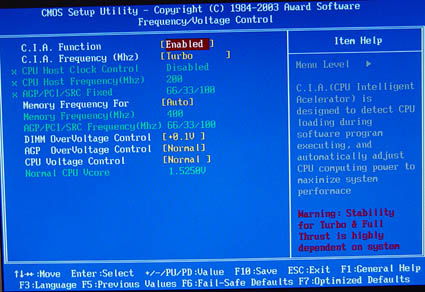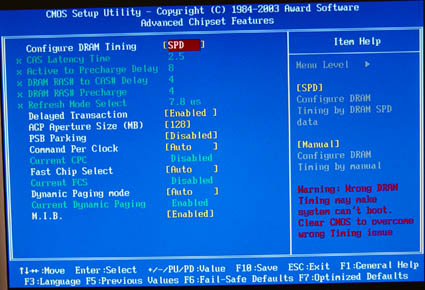Page 11 - BIOS & Overclocking
BIOS & OverclockingTweaking can be done at BIOS level. I must state that Gigabyte managed to do a nice job here if you know where to look that is!
But .... you are on Guru3D.com remember. When you are in the BIOS mainscreen then hit CONTROL+F1. You'll notice that the screen will reset and you now have a gazillion new options on-board ;) MIB, CIA, a plethora of memory timing options, such as CAS Latency, RAS to CAS Delay, RAS Precharge, and Precharge Delay.
With the following settings however you'll achieve a reasonable overclock. Changable settings are:
-
CPU Voltage up to 1.760 Volts
-
CPU Host Frequency (FSB) up to 248 MHz
-
Fixed PCI/AGP Frequency (33/66 - 50/100 - auto)
-
DDR:CPU Ratio (2.00x, 2.50x and auto)
-
AGP port voltage (+0.1 - 0.3 volts)
-
DDR Voltage (+0.1 to 0.3 Volts)
If you are a novice, then please do not use the CTRL+F1 function as you can seriously mess up your system stability.
Overclocking: If you would have an unlocked (engineering sample processor) you'll be able to change the multiplier also. As you can see there is plenty of room to play around with. Still, the Pentium 4 CPU in general has a reputation of being a good overclocker when increasing the FSB and it did just that. We where able to push the CPU towards a ~250 MHz FSB frequency rather easily (x4 is 1000 MHZ) with a 1,60 CPU core voltage and where able to get into windows to do our stuff perfectly fine even benchmarks like RTCW ran flawlessly. We had to settle down to get 100% stability though at 240 MHz FSB. As our CPU was now running at 3.36 GHz, memory performance was roughly 4800 MB/sec. We did some numbers with Return to Castle Wolvenstein as we always have believed it is very CPU dependant. And as you can see it is:
| RTCW - CPU in MHZ | 800x600 | 1024x768 | 1280x1024 | 1600x1200 |
| 2400 MHz | 108 | 106 | 97 | 84 |
| 2800 MHz | 128 | 128 | 127 | 115 |
| 3220 MHz | 142 | 143 | 136 | 118 |
| 3360 MHz | 147 | 149 | 141 | 120 |
| 3500 MHz | 154 | 154 | 145 | 121 |
The BIOS is very configurable and more than sufficient for the average tweaker/overclocker. While overclocked the CPU temperature in idle was ~ 44 degrees C which of course is nothing to be ashamed about, it reached 60-65 degrees C with 100% utilization with stock cooling.

You can also enable the C.I.A function if you are not sure what you are doing. The mainboard will be overclocking itself.
I have to remind you that overclocking heavily depends on many factors. Build of the CPU, Quality memory, and even PCI and AGP cards in your system can prevent a good overclock, all in all you have to be a bit lucky. Also if you overclocking with the FSB you might run into issues with Serial ATA. This is a common issue for almost any modern mainboard.

PAT - M.I.B
No no .. not Men in Black ! (props to Gigabyte's marketing department for that one). Intel recently made a .. well booboo. The 'big' performance difference between a 865 and 875 chipset is 5-8% based on optimizations in the chipset called the PAT function. On the 865 chipset this function is disabled, however it can be enabled really easy at BIOS level. And a lot of mainboard manufacturers did. In fact manufacturers like ASUS, ABIT, AOPEN, MSI, EPOX, Albatron did something with their mainboards to enhance performance. All of them found a way not to enable PAT as that would get them legal issues with Intel. Intel is putting a lot of pressure on the mainboard manufacturers not to enable PAT. And Gigabyte did not enable PAT as they formally state.
Remember that Control+F1 trick ? Good now look in the BIOS options for M.I.B and enable it. That's all it takes ;) Your memory performance has just boosted a few hundred MB/sec. There is a requirement to enable PAT though, you will need a Pentium 4 C class CPU, that's the one with the 800 MHz FSB.

